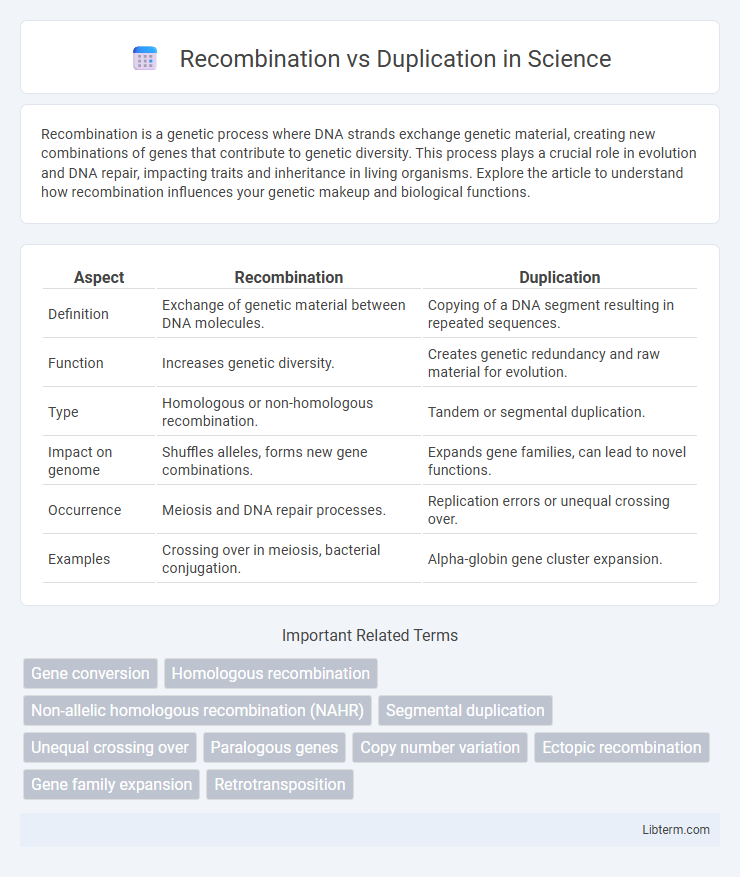Recombination is a genetic process where DNA strands exchange genetic material, creating new combinations of genes that contribute to genetic diversity. This process plays a crucial role in evolution and DNA repair, impacting traits and inheritance in living organisms. Explore the article to understand how recombination influences your genetic makeup and biological functions.
Table of Comparison
| Aspect | Recombination | Duplication |
|---|---|---|
| Definition | Exchange of genetic material between DNA molecules. | Copying of a DNA segment resulting in repeated sequences. |
| Function | Increases genetic diversity. | Creates genetic redundancy and raw material for evolution. |
| Type | Homologous or non-homologous recombination. | Tandem or segmental duplication. |
| Impact on genome | Shuffles alleles, forms new gene combinations. | Expands gene families, can lead to novel functions. |
| Occurrence | Meiosis and DNA repair processes. | Replication errors or unequal crossing over. |
| Examples | Crossing over in meiosis, bacterial conjugation. | Alpha-globin gene cluster expansion. |
Understanding Genetic Recombination
Genetic recombination involves the exchange of DNA segments between homologous chromosomes, creating new allele combinations that enhance genetic diversity. Unlike duplication, which produces extra copies of specific genes or genomic regions, recombination shuffles existing genetic material without increasing gene copy number. This process is critical for evolution, adaptation, and accurate chromosome segregation during meiosis.
The Basics of Gene Duplication
Gene duplication is a fundamental evolutionary process where an organism gains an extra copy of a gene, leading to genetic redundancy and potential novel functions. Unlike recombination, which shuffles existing genetic material to create diversity, gene duplication results in the presence of two or more identical sequences within the genome. This process provides raw material for evolutionary innovation, as duplicated genes can accumulate mutations and diverge without compromising the original gene's function.
Key Differences Between Recombination and Duplication
Recombination involves the exchange of genetic material between different DNA molecules, leading to new allele combinations, whereas duplication results in the copying of a DNA segment, increasing gene dosage. Recombination contributes to genetic diversity by reshuffling alleles during meiosis, while duplication can create gene families and enable evolutionary innovation through gene redundancy. Recombination affects the arrangement of existing genes, whereas duplication expands the genome content by adding extra copies of genes or chromosomal regions.
Molecular Mechanisms Involved
Recombination involves the exchange of genetic material between homologous DNA molecules through processes like homologous recombination facilitated by enzymes such as RecA and Rad51, enabling DNA repair and genetic diversity. Duplication arises from replication errors or unequal crossing over during meiosis, generating additional copies of DNA segments and often mediated by DNA polymerase slippage or non-allelic homologous recombination (NAHR). Both mechanisms contribute to genome variability, but recombination primarily rearranges genetic information, whereas duplication increases genome content.
Evolutionary Significance of Recombination
Recombination generates genetic diversity by reshuffling alleles during meiosis, enabling populations to adapt rapidly to environmental changes. This process increases evolutionary fitness by creating novel gene combinations that can be subject to natural selection. Unlike duplication, which increases gene copy number, recombination enhances variation without altering genome size, playing a crucial role in species evolution and survival.
Evolutionary Role of Duplication
Gene duplication plays a critical evolutionary role by generating genetic material that can acquire new functions without compromising the original gene's function, thereby increasing organismal complexity and adaptability. Unlike recombination, which reshuffles existing genetic variation, duplication creates novel genetic sequences that evolve independently, facilitating innovation and divergence. This source of raw material supports the development of new traits and can contribute to speciation and evolutionary diversification.
Recombination in Genetic Diversity
Recombination plays a crucial role in generating genetic diversity by reshuffling alleles during meiosis, leading to new allele combinations in offspring. This process increases variation within populations, providing raw material for natural selection and enhancing adaptability to changing environments. Unlike duplication, which simply copies genetic segments, recombination actively mixes genetic information, promoting evolutionary innovation.
Duplication as a Driver of Innovation
Gene duplication serves as a crucial driver of evolutionary innovation by creating genetic redundancy that enables divergence and the emergence of novel functions. Unlike recombination, which rearranges existing genetic material, duplication generates additional gene copies that may acquire beneficial mutations without compromising the original gene's function. This process fosters biological complexity and adaptability by expanding gene families and promoting functional specialization.
Recombination vs Duplication: Impact on Genomic Structure
Recombination reshuffles genetic material by exchanging DNA segments between homologous chromosomes, enhancing genetic diversity and altering genomic architecture. Duplication results in additional copies of DNA segments, expanding gene families and contributing to genome complexity and evolution. Both mechanisms significantly influence genomic structure by creating variations that drive adaptation and speciation.
Applications in Biotechnology and Medicine
Recombination enables the precise exchange of genetic material, facilitating the creation of genetically engineered organisms used in gene therapy and vaccine development. Duplication leads to gene expansion, providing multiple copies that can enhance protein production in biopharmaceutical manufacturing and synthetic biology. Both processes are essential for developing targeted treatments and improving genetic modification techniques in medical research.
Recombination Infographic

 libterm.com
libterm.com